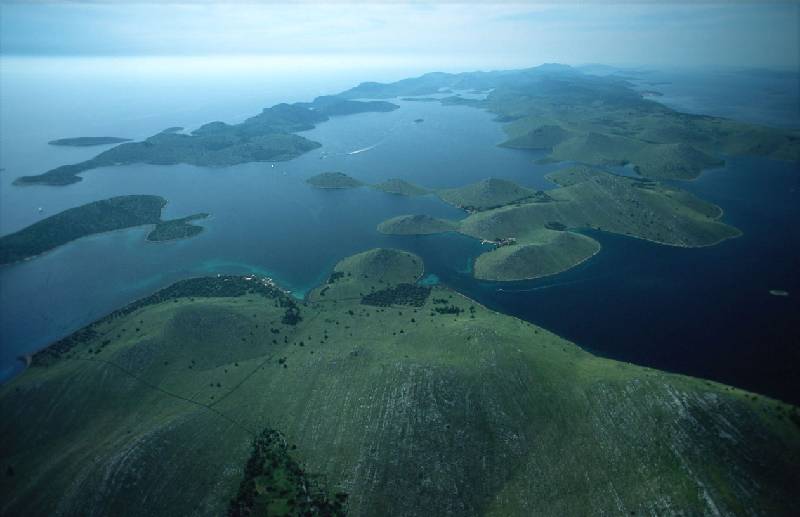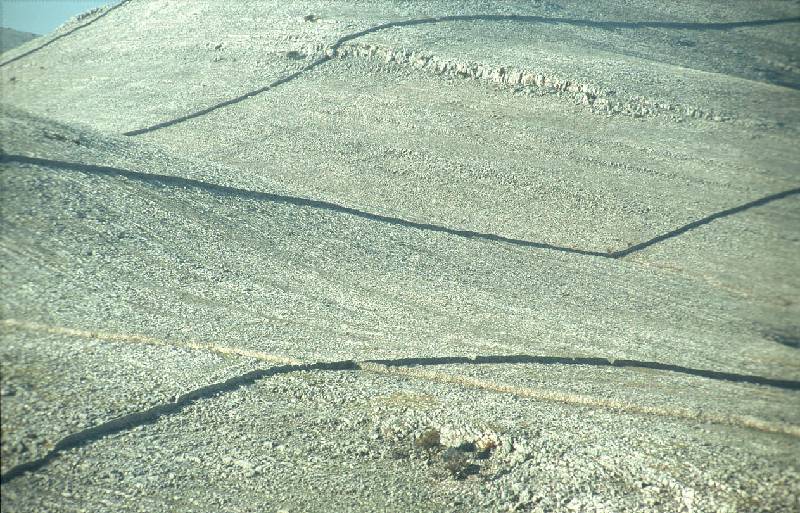Kornati
Kornati Islands is a group of about 130 islands, islets and reefs sprinkled in the deep blue sea of the Adriatic covering an area of about 64 sq km. The Kornati archipelago is in Dalmatia, a coastal region of Croatia just across the cities of Zadar and Sibenik.
The largest island is Kornat from which the archipelago takes its name. Other larger islands are, Piskara, Kurba Vela, Zut, Sit , Vrgada and Levrnaka. Apart from a tiny area of cultivated land with fig trees, olives and vineyards, Kornati islands are rocky, covered with thin grass, rare trees and Mediterranean scrubs.
Panorama of Kornati Islands – Piskera and Vela Panitula islands
Over the time erosion has been caused by the sea, overgrazing by sheep and fire. This erosion has deprived the islands of their primaeval luxurious vegetation, and the people have moved to more hospitable islands. Some of the bigger islands were inhabited during the Neolithic age by Illyrians. A number of wealthy families from Zadar and later Venice have claimed possession of the larger islands.
The Kornati have no permanent inhabitants, although the present owners from nearby larger Dalmatian islands periodically visit the Kornati to tend their vineyards and olive groves, bringing their sheep to graze. The sea around the islands is rich with fish and a variety of marine life… The islands have no spring water, only rainwater collected in water holes. The unique feature of the islands lies in their rugged shores with many caves and coves. The landscape of chalk limestone is covered with bushes of rosemary, juniper, lavender, thyme, myrtle and sage. Pathways leading to steep and huge cliffs facing the open sea and others gently decline towards the sea, ending in a small bay with a jetty and one or two fishermen’s cottages surrounded by pine, olives and fig trees…
Kornati archipelago, a wonderful natural attraction of Croatia is the largest archipelago in Adriatic sea, mostly uninhabited, where nature is truly untouched. These unusually bare islands, popular with visitors, laid out parallel to Croatian mainland. Viewed from above, the pebble-like chain is made of 140 odd islands, islets and reefs, covering 69 km2. Since the 1980s, the large part of this archipelago (89 islands, islets and reefs, covering 50 km2.) is Croatian National Park. The name of the islands comes from ‘corona‘ the Latin word for ‘crown‘.
The archipelago consists of two set of islands: Kornatski and Pucinski set, both equally beautiful although the surroundings around Pucinski is much more dramatic, due to its high cliffs, rocks and rugged coastline. The landscape is dominated by bare rocks and dry stone walls, covered by scattered low plants and bushes – grass, sage, iris, daffodils.
The islands are mostly owned by locals from Murter who have numerous cottages scattered around the lovely bays which they visit on weekends, in summer times or going there to keep their olive groves, vineyards or orchards. There are no sources of fresh water in the archipelago, so besides Tarac and Knežak rain ponds, drinking water is harvested by rainwater collectors.
Things To Do on the Kornati:
Sightseeing:
The largest village in the archipelago is Vruje on Kornat where you can wander around its streets and visit a cafe or local restaurant. All other settlements are much smaller. If you have a chance to visit the Kornati on the first Sunday in July, an interesting boat procession/pilgrimage takes place from Murter to the Gospa od Tarca church in Tarlac, the bay on Kornat. Beside Kornat, the second largest of these islands is Žut and Piškera where you can do some sightseeing too. There are numerous shoreline restaurants serving a variety of seafood all around the archipelago.
Swimming:
The whole archipelago is dotted by numerous secluded coves and bays, featuring smaller or larger pebble/shingle beaches while bay of Lojena on Levrnaka island has the only sandy beach in the archipelago. (GPS coordinates: 43.820633, 15.250558 / 43°49’14.3″N 15°15’02.0″E). Another popular swimming spot is Stiniva bay on Kornat (GPS: 43.807767, 15.339162 / 43°48’28.0″N 15°20’21.0″E) where you can have a drink in local konoba/restaurant.
Snorkelling:
If you take your snorkelling kit with you, you can enjoy yourself observing local sea life that, among others, include seeing loggerhead sea turtle (Caretta caretta) – morska kornjaca, bottlenose dolphins – dupin, noble pen shell (Pinna nobilis) – periska/lostura, giant tun (Tonna galea) – veliki spuz.
Bird watching:
Pallid Swift (Apus pallidus) and common shag (Phalacrocorax aristotelis) are frequenting the archipelago and can be seen any time of the year.
Fishing:
Fishing is very limited in the Park, designated to specific areas, so make sure you get your fishing licence and map of allowed fishing areas in the local tourist office in Murter.
Sailing:
Popular among the Adriatic sailors, the archipelago has two fully equipped marinas: ACI Marina Piškera island and ACI Marina Žut island although the anchorage is allowed in every single bay of the archipelago.
Scuba Diving:
Scuba diving is also popular here – clear waters and untouched marine life offers lovely dives in nine designated diving zones of the National Park. Diving is only allowed in organised diving groups authorised by National Park, so check the availability in the local tourist office. Diving permits cost 100 HRK per person on the top of the entrance fee.
Accommodation on the Kornati islands
Accommodation within a park is limited and consist of mostly small off-grid fisherman stone cottages owned by locals. The accommodation is scarce and needs to be booked well in advance especially for the high season. There are no hotels nor campsites in the area. Here is a selection of cottages to let that are equipped with solar panels and gas stoves:
 |
You can also try to rent your accommodation via local travel agents who do accommodation packages including boat transfers, admission fees, gas cylinders and logistics: touristagency-lori.hr; adamo.hr; kornatica.com
Getting to the Kornati islands
There is no public transport to the Kornati, no ferries are sailing there (yet), so most visitors book a trip by excursion boats from Murter (mainland), Sali (Dugi Otok), Zadar or Sibenik. However, the best way to experience the Kornati is to spend some time sailing around the archipelago, whereby you can stop in any bay you wish and stay as long as you wish.
Day-trips to the Kornati
Day-trip usually starts at around 8 am taking you for a boat ride around the islands, stopping on several locations for swim, dive or food breaks. By 6 pm you are usually back to your base. The cheapest and shortest boat trips are from Murter as it is the nearest point to the Park. The day excursion costs start from about 300 HRK per person. The entrance to the park is included in the price.
Entrance fees to Kornati National Park:
If you have your own transport (i.e vessel) the entrance fees – ticket prices for National Park are between 150 and 300 HRK per day, depending on the size of the vessel and entry location, so if you have smaller vessel the fees will reflect it. As National park wardens operate in small and fast speedboats, cruising the archipelago, selling entrance tickets, you don’t need to buy your tickets in advance nor sail through designated entrance points (Opat and Vela Proversa)
More information on the Kornati islands:
- visit National Park official site: www.np-kornati.hr to find more details about visiting this lovely archipelago
- once in Murter, visit Kornati National Park visitors information centre – address: Butina 2, Murter, Croatia; where you can get all sorts of info, leaflets, advice and brochures about visiting Park.
- As there are no permanent settlements in Kornati islands, the nearest island with hotels is Murter where one can stay to visit the Kornati. Also, staying in Dugi Otok, Vodice, Biograd, Zadar or Sibenik will be close to visit the Kornati Islands. As there are no ferries between the mainland and the Kornati islands, to visit the Kornati you can book an excursion from neighbouring places.
Photos:
- Vruje
- Archipelago
- Cliffs of Kornati
- Clouds and sea
- Kornati archipelago
- Lavsa
- Piskera
- sailing in Kornati
- Mali Kornat
- landscape pattern
- sunset in Kornati
- another sunset
- Kornati Islands (National Park of Croatia) – official website of Kornati, Croatian National Park. There are 89 islands, islets and reefs within the area of Kornati National Park…
- Kornati Islands – Nautical Large Map – very large and detailed map of Kornati Islands
- Croatian Islands Travel News and Articles – latest news from around Islands of Croatia
Kornati Travel Articles:
- Zut allure – back to basics in the Kornati islands For some, staying for a week on a rocky, low-lying island covered in scrub and gorse – no beaches, no roads, no shops, no night-clubs – in a former fisherman’s cottage without a bathroom and only a bucket-flush loo, may not be quite enough to induce thoughts of holiday nirvana. However, as I lay in the sun, novel in hand and the sea lapping at my feet, I was happy. Zut, my home for a week, is one of the 147 Kornati islands…read more













 Subscribe
Subscribe